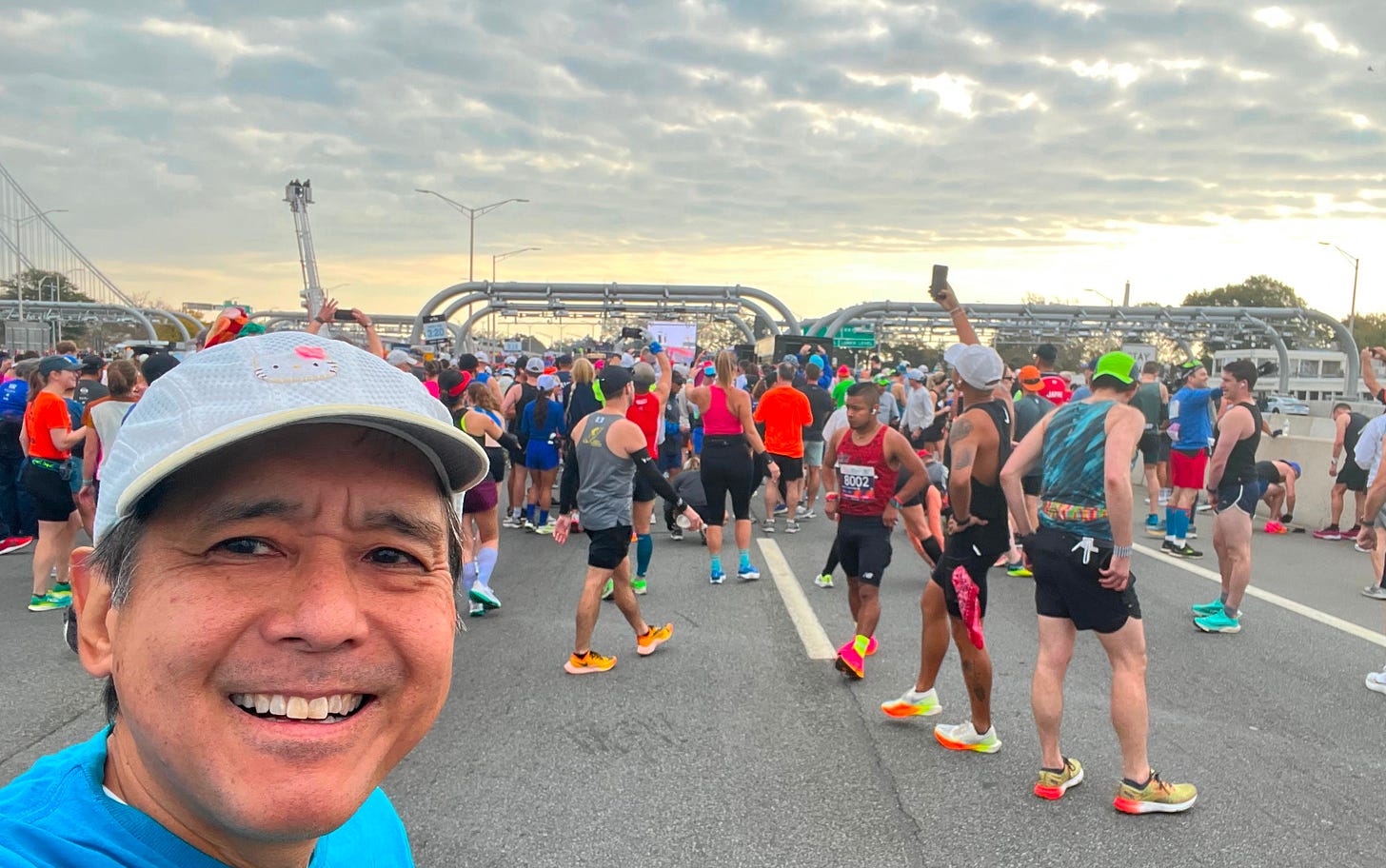The 5 NYC Marathon bridges ranked (+ 4 other non-bridge hills)
Your guide to conquering the NYC Marathon's ups and downs
I’ve run 17 NYC Marathons, with every finishing time between 3:30 and 4:09.
Successful hill running is both a physical and mental challenge. These descriptions of each of the marathon’s bridges and other climbs is my latest attempt to REALLY power through them this year.
I’ve included 🗻 icons to rate the difficulty of the climbs. The ratings take into account steepness, race stage and crowd support.
1. Queensboro Bridge: Degree of Difficulty = 🗻🗻🗻🗻🗻
Climb: 103 feet over 0.55 miles
At Mile 15, fatigue is looming. Coupled with no spectators, climbing the Queensboro Bridge is a mental and physical challenge.
Runners around you will be struggling. There are no aid stations on the bridge.
If you need a walking break, this is the easiest stage in the race to take it. Others will be walking and no spectators will try to urge you on.
Once you hit the 15 mile marker you are close to halfway through the climb.
Shortly after that, square blue signs count down how much more of the bridge you must endure. Consider taking a photo of Manhattan on your left.
Take a break from your headphones and listen to the footsteps. You will soon hear crowd noise from Manhattan. Use their cheering to pull you forward. You’ll begin to descend, passing the Mile 16 sign. Take care on the descent!
2. Willis Avenue Bridge: Degree of Difficulty = 🗻🗻🗻🗻
Climb: 41 feet over 0.3 miles
You will cross the Willis Avenue Bridge between mile markers 19 and 20. Other runners will have hit the wall by now.
This climb seems so much steeper than it really is. Know this is the last major bridge you’ll cross in the marathon.
3. Verrazano Bridge: Degree of Difficulty = 🗻🗻🗻

Climb: 150+ feet over 1 mile
Euphoria at the start more than cancels out how difficult climbing the Verrazano Bridge is.
Allow this excitement to distract you. Resist the urge to run fast. Try not to get frustrated by people taking selfies or running together with a large group blocking the road.
Breathe, move your arms and just get to the top. Then be careful about your descent. Don’t try to make up all the time you lost getting through Mile 1.
4. Pulaski Bridge: Degree of Difficulty = 🗻🗻
Climb: nearly 40 feet over 0.4 miles
You will hit the halfway point while ascending the Pulaski Bridge.
If it’s a warm day, the sun can beat down on you as you cross the bridge. The climb is not very steep. Take stock of how you’re feeling as you cross 13.1. Consider slowing down and taking a photo of yourself with Manhattan in the background.
The climb is steeper than the descent. You will be in Queens for the next couple of miles.
5. Madison Avenue Bridge: Degree of Difficulty = 🗻
Climb: 12 feet over 0.15 miles
After zigzagging through the Bronx runners return to Manhattan.
There’s hardly an uphill slope to cross the Madison Avenue bridge. Spectators have “Last Damn Bridge” signs to commemorate the crossing, which happens as you hit the Mile 21 marker.
I love the miles in Harlem, which feature a wide Fifth Avenue with just a few turns and the right amount of spectators.
Other hilly sections
🗻 Brooklyn, Mile 9: You climb nearly 60 feet over half a mile. This is an intense part of the race on very narrow Lafayette Avenue, with a ton of spectators. The energy level is so high here - I don’t notice this climb.
🗻 Fifth Avenue in Manhattan: Mile 24 is a steady ascent of 100 feet over a mile. I don’t notice the climb because I’m usually trying to survive at this stage.
🗻🗻🗻🗻 Central Park Hills: There are two noticeable climbs, each 40 feet over 1/4 of a mile. The downhills make the Central Park Hills challenging. In recent years the number of spectators have grown considerably, so there’s no shortage of encouragement.
🗻🗻From the Mile 26 sign to the finish: This climb is only 15 feet over a 1/4 mile but it feels like much more.



